What is Dynamic Neuromuscular Stabilization (DNS)?
A rehabilitation strategy based upon developmental kinesiology and the neurophysiological aspects of maturing postural and locomotor systems in the body.
This essentially boils down to looking at human motion during the first years of life in the process as we learn to have ideal: Posture, Breathing Patterns, and Joint centration
**Joint Centration: Joint position to provide the most optimal utilization of musculature
Maximum force-loading on via musculature loading with minimum tension on passive structures (joints and ligaments)
Why use this approach for rehabilitation and exercise?
This is a treatment, exercise, and rehabilitation method that helps reprogram the brain to restore posture, stability and ideal movement throughout the body.
Allows for an assessment and treatment style to integrate: Core stability prior to movement, Optimal stability DURING movement leading to ideal overall function of the body.
What is the Rationale and Reasoning for using DNS?
During the first few years of life, the Central Nervous System (CNS) is developing movement patterns (ideal ways to move) in the first 13 months.
Development of the CNS creates: Stability, joint centration, ideal posture, and flawless movements
Ideally, children develop movement as seen below:
1) Laying on their back --> 2) Rolling over --> 3) Crawling --> 4) Sitting Upright --> 5) Walking unassisted
Injuries and pain that develops throughout life lead to altered movements and compensations leading to: Abnormal posture, unstable joints, and strained muscles
These compensations will develop throughout life as you continue to challenge your body in different ways
If compensations persist long-term this can lead to: arthritis, tendinitis, bursitis, and further injury
Where to start with DNS?
Breathing! We have talked about intra-abdominal pressure and the importance of having proper breathing patterns in a previous blog post.
If breathing is shown to be dysfunctional, you will see an increase in force placed upon different joints or musculature.
DNS focuses on training the brain and challenging you to focus on certain movements
Quality over Quantity in movements.
If you are repetitively loading a joint incorrectly it will fatigue in the end and could lead to injury and compensations
Poor Breathing Patterns can lead to these different types of compensations as seen below (1-4)
Diaphragm (structure above downward pointing arrows) and pelvic floor (structure below upward pointing arrows work together to stability lower thoracic and the lumbar spine
"Open Scissors Syndrome": Increased tension on low back, overactive upper back musculature leading to chronic tension between shoulder blades; Tightness and popping/clicking in the front of the hip
Forward Drawn Chest: Tight upper back; Lack of movement in upper back; Rounded shoulders; Shortened pectoralis major leading to pain in the mid-back
Chest behind Pelvis leading to similar distribution of chronic tension and pain as (3).
Take Homes:
Dynamic Neuromuscular Stabilization identifies overall movement based upon breathing patterns to give ideal movement output of the body
Breathing is important as it effects the way the body will compensate
Selective Functional Movement Assessment is a strong tool to be applied at identifying where the compensation is occurring and driving pain at different locations of the body
Quality of movement is more important than Quantity when trying to move from Rehabilitation to Exercise




